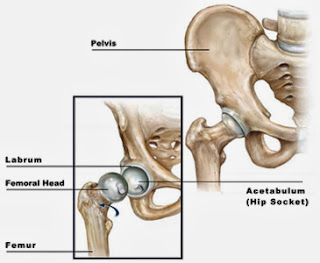"To keep the body in good health is a duty... " - Buddha
The joints
in our bodies are protected by two types of cartilage. Hyaline cartilage covers the surface of the
bones and protects them from the friction damage that would occur if the bony
surfaces rubbed against each other.
White fibrous cartilage can be found in joints that are subjected to
frequent stress. This type of cartilage
helps keep joints intact and acts as a shock absorber.
Movements
that are repeated over and over again will gradually
start to wear away cartilage just as a stream will erode the surface of a rock over time. When
joints are placed in unnatural positions, such as a turned out position, the
body’s weight cannot be distributed normally over the joint, and undue stress
is placed upon it. Unnatural joint positions also occur when the dancer's body is misaligned or the dancer has a muscular imbalance. When this stress is
combined with repetitive movements, tiny tears
begin to occur in the cartilage. After a
while these tears increase and result in bigger tears. Additionally, jumps, leaps, pivots, and turns
create enough force to cause cartilage damage on their own. It is not surprising then that those who
participate in ice hockey, soccer, football, golf, and ballet are at a greater
risk for developing tears in the cartilage of the hip joint.
 |
| From arthroscopichipsurgeon.com |
The labrum is a ring of white fibrous cartilage that can be found along the edge of the acetabulum, or the socket in the pelvis where the femur sits. Its job is to hold the femoral head in place by increasing the depth of the hip socket.
The labrum
often tears away from the acetabulum due to overuse and small injuries that may occur during twisting or
pivoting movements and accumulate over time.
Dancers who experience a labral tear may complain of pain in the front
of the hip, feel a “catch” in the joint when moving, experience stiffness in
the hip, and/or have a limited range of motion at the joint. These feelings may get worse after a
long walk, or after staying in one position for a long time. As the tear grows, the pain may radiate
down the leg, to the side of the hip, or toward the lower back, and may become
constant enough and severe enough to cause the dancer to avoid certain
exercises and/or lessen the amount of time spent in class or rehearsals.
If left
untreated, a torn labrum can cause a shift in the way the femoral head sits in
the acetabulum and increase the stress on the joint, predisposing the dancer to
arthritis.
 |
| From arthroscopichipsurgeon.com |
If physical
therapy does not work, or if the tear is too severe, surgery may be
required. During the surgery, any pieces
of cartilage that have completely torn off can be removed, and the surgeon will
trim the torn edge of the labrum and re-attach it to the edge of the
acetabulum. The recovery time for this
type of surgery is a long one – 4-6 months with physical therapy for
rehabilitation.
The good
news is that, although labral tears have been very common among ballet dancers,
dance medicine specialists believe that education can play a key role in
decreasing the risk. Providing both
dance educators and dancers with information about proper anatomical training,
the dangers of muscular imbalances, the dangers of fatigue and overuse of the
body, and the benefits of cross-training can help produce healthier dancers who
can dance longer, stronger and happier without this type of injury.
